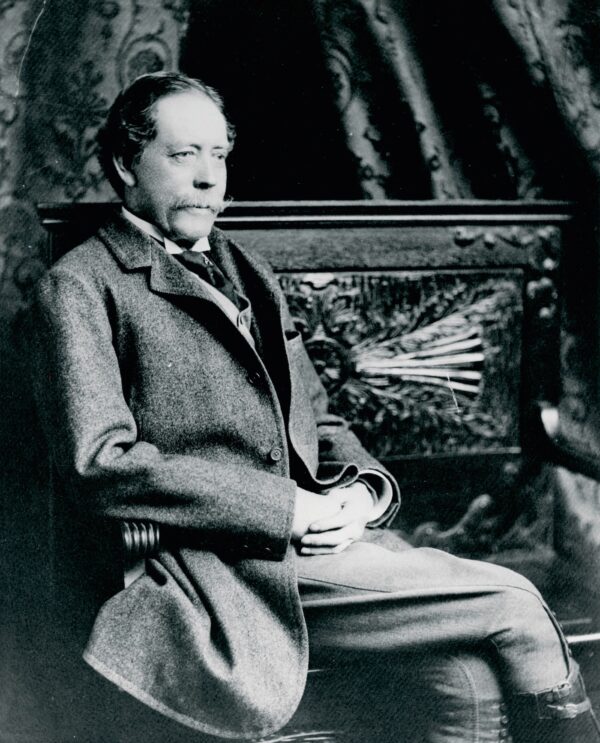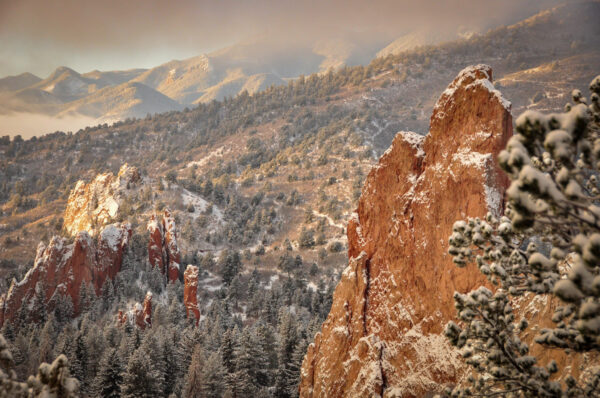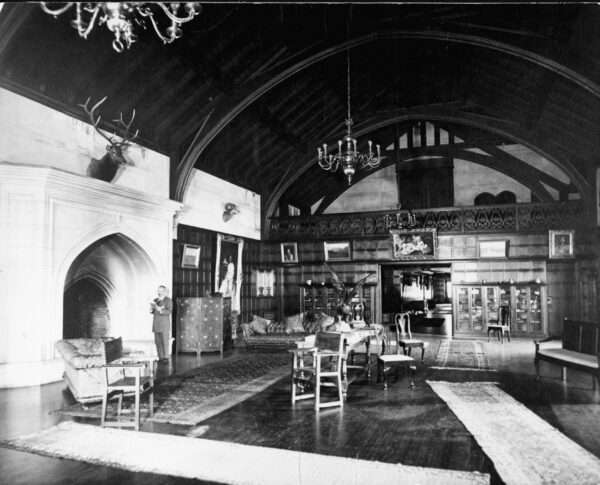A Tudor Castle Built For His “Queen” With Cutting-Edge-Technologies
Distressed Patriotic Flag Unisex T-Shirt - Celebrate Comfort and Country $11.29 USD Get it here>>

Glen Eyrie Castle is a magnificent English Tudor Revival house with a view of Colorado’s Garden of the Gods. Designed by Frederick J. Sterner and Thomas MacLaren, it is actually the second house built on the site. Both were constructed for William Jackson Palmer, the founder of Colorado Springs.
When Palmer first saw the valley which would become Glen Eyrie, he was instantly enchanted. He wrote a letter to his fiancée Mary (whose nickname was “Queen”), penning the words, “Someday there will be a great resort here—the mineral springs will be useful—and people will come as soon as the railroad arrives.”
The founding of Colorado Springs was driven by Palmer’s aspiration to build a beautiful town that attracted people who wanted to come for the healthfulness of the climate and the respite of the incredible scenic beauty. Its construction was influenced by Palmer’s desire to create a settlement built on sustainability and conservation. Like his English mentors, he built for the future.
A Legacy of Service
Palmer’s story is a fascinating one, and it begins with his birth in Kent County, Delaware, in 1836. He grew up in a Quaker family, and when he was 5 years old, the family moved to Germantown, near Philadelphia, Pennsylvania. When Palmer was 15, he worked as a clerk in the engineering department of the Hempfield Railroad. At 17, he worked under chief engineer Charles Ellet Jr. as a rodman and quickly moved up to becoming a transit man for Hempfield in 1854.

Palmer’s uncle, Frank H. Jackson, urged him to visit England to study their railroads and coal-fired steam engines. At the time, American locomotives were high-stacked wood burners. In 1855, Palmer traveled abroad for a six-month period and met England’s greatest railroad engineers: Isambard Kingdom Brunel and Robert Stephenson. These were men of vision, and their beautifully crafted bridges and tunnels still carry British Railway traffic today. Under their tutelage, Palmer would begin to develop a vision of his own for American railroading.
Returning to America, Palmer went to work for the Pennsylvania Railroad, and he created a plan for converting the company’s wood-burning locomotives to run on coal. Palmer’s work was key to the future of American railroading: Coal was not only cleaner than wood, it was considerably more abundant—available in quantities sufficient to support a century of American railroad expansion and operation.
When the Civil War broke out in 1861, Palmer joined the Union Army, stating, “Slavery is a greater evil than war.” Although his Quaker upbringing inspired him to be a pacifist, he considered the eradication of slavery something worth fighting for. Palmer’s distinguished service earned him the rank of general, as well as the Medal of Honor. After leaving the Army, he resumed his passion for railroads.
In 1870, Palmer and his partners founded the Denver and Rio Grande Railroad. In contrast to the tawdry “Hell on Wheels” railroad towns associated with Western expansion, Colorado Springs was a clean, orderly bastion of temperance.
Palmer had first seen the geological region in 1869, while on a surveying trip for the Kansas Pacific Railroad, and instantly fell in love with it. The region was rich in necessary resources—coal, water, and land—and its beauty was enchanting.

Upon his discovery of the land, Palmer wrote in a letter to Queen, “I found the magnificent Pikes Peak towering immediately above at the elevations of over 14,000 ft., topped with a little snow. I could not sleep anymore with all the splendid panorama of mountains gradually unrolling itself.”
It was here that Palmer chose to build his home.
Foundation of a Dream Home
Palmer and Queen married in 1870. Fascinated by the castles and grand estates of Europe, they returned from their honeymoon in England and began the construction of their dream home. Queen became a teacher in Colorado Springs’s first school, and the couple had three daughters: Elsie, Dorothy, and Marjory.
Palmer hired landscape architect John Blair to design the rose gardens and grounds of the estate. Blair noticed an eagle’s nest on the side of a rock formation that towered over the estate and suggested the property be named Glen Eyrie (Valley of the Eagle’s Nest).
The Carriage House was the first structure built on the property in 1871. The Palmers lived in the upper stories while they were waiting for the main house to be built. The original Glen Eyrie was a frame house in the Victorian style, built in the form of a Latin cross and featuring 27 rooms. It was sited on the banks of Camp Creek, at the entrance to the Garden of the Gods (an amazing ridge of red rock formations that is sacred to the Ute people). A staunch defender of indigenous peoples, Palmer invited the Ute to the Garden of the Gods to celebrate Shan Kive, their festival of sacred dances.
The first major architectural additions were constructed in the 1880s, adding a Gothic tower. The room in the tower was reserved for Queen and her artistic pursuits. Sadly, the house’s metamorphosis into a Tudor castle happened while Palmer’s wife was no longer in residence. She suffered a heart attack in 1880, and doctors advised her to seek out a lower elevation.
In 1885, Queen permanently left Glen Eyrie with her daughters and lived out her last years in England. Multiple heart attacks prevented her from ever returning to the castle, but Palmer visited the family frequently. After her death in 1894, her three daughters returned to Glen Eyrie. As a tribute to Queen, Palmer and his daughters continued to renovate the house in the style of a fine castle.

Aesthetics and Sustainability
In an era before the grid existed, Palmer consciously constructed the buildings to be a model of sustainability. He loved to keep up with the latest innovations and would continually incorporate them into his home. He built his own water supply and electrical generating station and had one of the first telephones in the city. He also had fire and lightning suppression systems installed in the house, as well as a central vacuum and weather vane. The smoke from the 27 fireplaces was piped into a remote stack to prevent polluting the air around the house.
The castle that stands today was built between 1904 and 1905. The main part of the castle sits on the footprint of the old house. Palmer remodeled Glen Eyrie into a Tudor style castle with the defining characteristics of Victorian Revival architecture: cross-timber or half timbering (the upper half of the wall is timber-framed with stucco while the lower wall is constructed of stone or brick). What makes Glen Eyrie unique is that it skillfully blends elements of Gothic Revival (evident in the castle’s tower and stonework) and Tudor Revival (seen in the cross-timbering and gable proportions).
In 1907, William Palmer was injured in a horse-riding accident. Paralyzed, and no longer able to travel, he nonetheless hosted the veterans of his 15th Pennsylvania Volunteer Regiment for their annual reunion. He provided, at his own expense, a special train to bring them all to Glen Eyrie. He entertained them in the 2,152-square-foot great hall, where massive beams, paneled walls, and a great stone fireplace surrounded the soldiers with old-world grandeur.
Today, Glen Eyrie Castle is owned and maintained by the Navigators, a Christian ministry that is based in Colorado Springs. It is a quiet and peaceful respite in the midst of mountain grandeur, conducive to spiritual reflection and restoration. Guests may stroll on the trails around the castle, where wild turkeys, deer, and squirrels abound—continuing Palmer’s commitment to conservation. The courteous and attentive staff welcome guests in the same spirit as the benevolent and civic-minded William Jackson Palmer.
This article was originally published in American Essence magazine.





